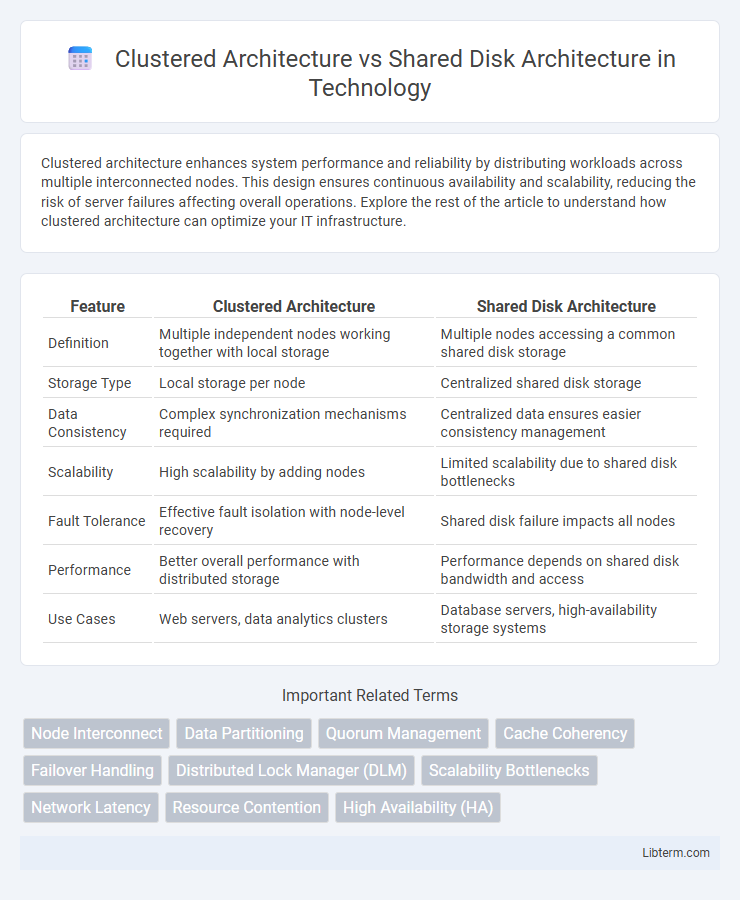Clustered architecture enhances system performance and reliability by distributing workloads across multiple interconnected nodes. This design ensures continuous availability and scalability, reducing the risk of server failures affecting overall operations. Explore the rest of the article to understand how clustered architecture can optimize your IT infrastructure.
Table of Comparison
| Feature | Clustered Architecture | Shared Disk Architecture |
|---|---|---|
| Definition | Multiple independent nodes working together with local storage | Multiple nodes accessing a common shared disk storage |
| Storage Type | Local storage per node | Centralized shared disk storage |
| Data Consistency | Complex synchronization mechanisms required | Centralized data ensures easier consistency management |
| Scalability | High scalability by adding nodes | Limited scalability due to shared disk bottlenecks |
| Fault Tolerance | Effective fault isolation with node-level recovery | Shared disk failure impacts all nodes |
| Performance | Better overall performance with distributed storage | Performance depends on shared disk bandwidth and access |
| Use Cases | Web servers, data analytics clusters | Database servers, high-availability storage systems |
Introduction to High-Availability Database Architectures
High-availability database architectures ensure continuous access and minimal downtime by employing Clustered Architecture or Shared Disk Architecture. Clustered Architecture involves multiple servers with independent storage working together to provide fault tolerance and load balancing. Shared Disk Architecture centralizes data storage accessible by all nodes, facilitating seamless failover and coordinated access to maintain data consistency during server outages.
Understanding Clustered Architecture
Clustered architecture consists of multiple independent servers or nodes that work together to provide high availability and scalability by sharing workloads and data through inter-node communication. Each node has its own private storage and processing power, allowing it to handle requests autonomously while synchronizing state information with other nodes to maintain consistency. This design optimizes fault tolerance and resource utilization compared to shared disk architecture, where multiple nodes access a common storage system directly.
Overview of Shared Disk Architecture
Shared Disk Architecture allows multiple servers to concurrently access a single centralized storage system, enhancing resource utilization and simplifying data management. This architecture supports high availability and scalability by enabling seamless failover and load balancing among nodes, with all servers sharing direct access to disk subsystems. It is commonly implemented in clustered database systems and storage area networks (SANs) to ensure consistent data access and maintain data integrity across all connected servers.
Key Components of Clustered Architecture
Clustered Architecture consists of multiple interconnected nodes working together, each with its own processor, memory, and local storage, enabling high availability and scalability. Key components include cluster nodes, a communication interconnect for data exchange and synchronization, and a cluster manager responsible for resource allocation and failover management. This architecture maximizes fault tolerance by distributing workload and maintaining data consistency through coordinated control mechanisms.
Key Components of Shared Disk Architecture
Shared Disk Architecture key components include a centralized storage system accessible by multiple servers, ensuring data consistency and high availability across nodes. The shared storage typically consists of redundant arrays of independent disks (RAID) or storage area networks (SAN) that provide fault tolerance and scalability. Cluster managers coordinate access to the shared disk to prevent conflicts and maintain synchronization, enabling efficient resource sharing and load balancing.
Performance Comparison: Clustered vs Shared Disk
Clustered architecture delivers superior scalability and fault tolerance by distributing workloads across multiple nodes, reducing bottlenecks and improving overall system responsiveness. Shared disk architecture centralizes data storage, which can create contention and latency due to concurrent access, limiting performance under high loads. Performance benchmarks show clustered systems excel in handling high transaction volumes with lower latency, while shared disk setups may struggle in throughput and recovery speed during node failures.
Scalability in Clustered and Shared Disk Systems
Clustered architecture offers superior scalability by enabling multiple nodes to independently process workloads and expand resources dynamically, minimizing bottlenecks. Shared disk architecture faces scalability challenges due to contention over a single storage pool, often requiring complex coordination mechanisms to manage concurrent data access. Scalability in clustered systems benefits from distributed processing and resource allocation, whereas shared disk systems typically experience increased latency and limited growth potential as the number of nodes increases.
Fault Tolerance and Data Consistency
Clustered architecture enhances fault tolerance by distributing workload across multiple interconnected nodes, allowing failover without service interruption and maintaining data consistency through synchronized replication protocols. Shared disk architecture relies on a centralized storage system accessible to all nodes, ensuring data consistency via a unified storage layer but introduces potential single points of failure that can compromise fault tolerance. Both architectures implement mechanisms such as distributed locking in clustered setups and failover clustering in shared disk environments to balance data integrity with system availability.
Use Cases: When to Choose Clustered or Shared Disk
Clustered architecture is ideal for high-availability applications requiring fault tolerance and load balancing across multiple nodes, such as web servers and big data clusters where data locality improves performance. Shared disk architecture suits environments needing centralized storage with concurrent access, like database management systems and virtualized infrastructures demanding simplified data consistency and maintenance. Choosing clustered architecture supports distributed processing with scalability, while shared disk architecture excels in scenarios emphasizing data integrity and ease of backup.
Future Trends in Database Architectures
Clustered Architecture enhances scalability and fault tolerance by distributing data processing across multiple nodes, making it ideal for handling large volumes of real-time data in cloud-native environments. Shared Disk Architecture offers simplified data management and strong consistency due to centralized storage but faces challenges in latency and throughput as workloads grow. Future trends emphasize hybrid models combining clustered processing with shared storage resilience, leveraging advances in NVMe over Fabrics and persistent memory to optimize performance for distributed database systems.
Clustered Architecture Infographic

 libterm.com
libterm.com